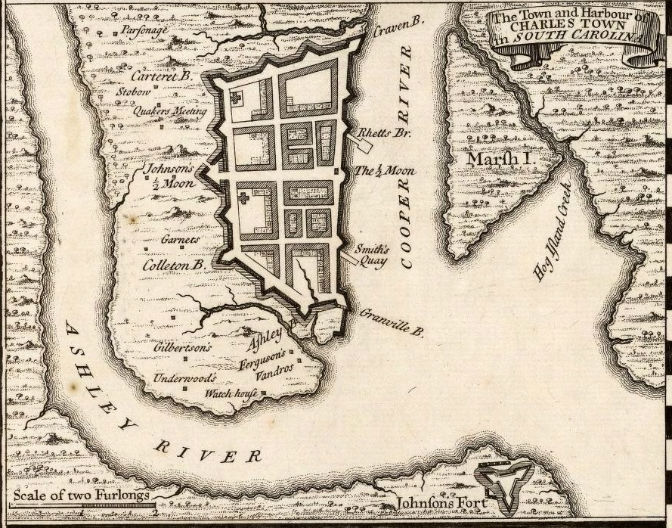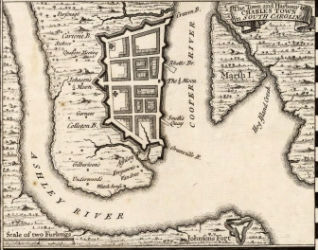
CHARLESTON, S.C. (AP) – As soon as it became clear that the building housing Charleston Cooks store was going to be demolished for a new hotel, local historians thought the ground underneath could hold tantalizing clues to the city’s earliest years.
They were right, sort of.
The historians are part of Charleston’s Walled City Task Force, a decade-old group whose goal is to discover, interpret and preserve the city’s late 17th and early 18th century fortifications.
They were recently welcomed onto the muddy, exposed construction site at 194 East Bay St. to take a close look at what appeared to be a small section of the city’s wharf wall.
Carter Hudgins, director of Clemson’s and the College of Charleston’s joint Graduate Programs in Historic Preservation, likened the potential find to the modern discovery of Hadrian’s Villa in Rome.
“It’s Charleston’s equivalent of finding a very early, rarely seen part of its history,” he said.
Of all the cities in England’s colonies, only Charles Towne had a wall, one built not only to protect the city from the Spanish and French but also to stabilize its waterfront near present-day East Bay Street.
The wall was built of earth and wood along the northern, western and southern parts, but its eastern section featured a half-mile-long brick wall along the water, dotted with angled points (redans) and other defensive works.
Nic Butler, a historian with the Charleston County Public Library and author of the walled city task force’s blog, said the structure used more than 7 million bricks, based on surviving receipts for the work.
Work on the wall had begun by 1696, but a hurricane washed much of it away in 1700. Construction resumed after that, and it was largely finished by 1712.
The brick portion ran roughly from the northern tip of the High Battery, at 40 East Bay St., to the area underneath the steps of the U.S. Customhouse at Market and East Bay.
The walls were largely dismantled and lowered to street level after the Revolutionary War, and mostly lived on solely through old maps and history texts. In 1965, however, archaeologists uncovered a large section of the wall’s Half Moon Battery under the Old Exchange Building.
In the 21st century, Charleston created a task force to learn more about the wall, including where its remnants could be found. One of its earliest successes was unearthing a large redan, or pointed structure, just south of South Adgers Wharf.
A few other digs also have found small portions; others have found nothing at all.
The city has no archaeology ordinance to require exploration on old sites such as this, but property owners sometimes cooperate, as was the case at 194 East Bay.
Katherine Pemberton with the Historic Charleston Foundation had been walking by the construction site regularly to see if any bricks were exposed. On Wednesday, a tour guide glimpsed some and spread the word.
The owner and contractor allowed Pemberton, Charleston Museum archaeologist Martha Zierden and others to access the site for closer inspection.
They found a small section of brick whose bright red color and stark white mortar was near identical to previous portions of the wall uncovered in recent years.
“That’s the sign,” Pemberton said of the colors. “It’s so distinct. When you hit it, it’s not like anything else.”
The workers also uncovered a 2-foot wide section of bricks just east of the sidewalk, but those were darker and apparently part of the foundation of a structure built after the wall was lowered to street level around 1785.
But the bricks believed to be part of the wall were not parallel to East Bay, as expected. Instead, they might have formed a sort of buttress, Butler said.
Remnants of the wall still might be found underneath the bluestone sidewalk.
Mark Wyant, the owner of The Saint hotel, said he was happy to provide the access. As a history buff, he said he had hoped an exposed wall section would have run through his lobby so he could show part of it off with a special glass floor.
Wyant said he hopes to work with the city about exploring under the sidewalk during a later stage of construction work.
“Whatever is there we want to try to preserve if it’s historically significant,” he said.
There is strong public interest in the story behind Charleston’s early walls, at least judging by how most passersby stopped to snap photos, ask questions and angle for a better look.
Butler said that while the original wharf wall apparently does not run through the hotel property, “the good news is it’s still discoverable after the hotel is built.”
___
By ROBERT BEHRE, The Post and Courier of Charleston
Information from: The Post and Courier, http://www.postandcourier.com
___
Copyright 2019 Associated Press. All rights reserved. This material may not be published, broadcast, rewritten, or redistributed.Information from: The Baltimore Sun, http://www.baltimoresun.com
AP-WF-03-01-19 1859GMT



